Etheric.com eShop!
Cart
Search
Other sites of Interest
Evidence for a Solar Cause of the Pleistocene Mass Extinction
Radiocarbon, vol. 53, No. 2 (June 1, 2011): 303 – 323
Abstract
The hypothesis is presented that an abrupt rise in atmospheric radiocarbon concentration evident in the Cariaco Basin varve record at 12,837±10 cal yrs BP contemporaneous with the Rancholabrean termination, may have been produced by a super-sized solar proton event (SPE) having a fluence of ~1.3 X 1011 protons/cm2. A SPE of this magnitude would have been large enough to deliver a lethal radiation dose of at least 3 – 6 Sv to the Earth’s surface, and hence could have been a principal cause of the final termination of the Pleistocene megafauna and several genera of smaller mammals and birds. The event time-correlates with a large magnitude acidity spike found at 1708.65 m in the GISP2 Greenland ice record, which is associated with high NO-3 ion concentrations and a rapid rise in Be-10 deposition rate, all of which are indicators of a sudden cosmic ray influx. The depletion of nitrate ion within this acidic ice layer suggests that the snowpack surface at that time was exposed to intense UV for a prolonged period which is consistent with a temporary destruction of the polar ozone layer by solar cosmic rays. The acidity event also coincides with a large magnitude, abrupt climatic excursion and is associated with elevated ammonium ion concentrations, an indicator of global fires.
Download: SPE.pdf (File size: 1 MB)
